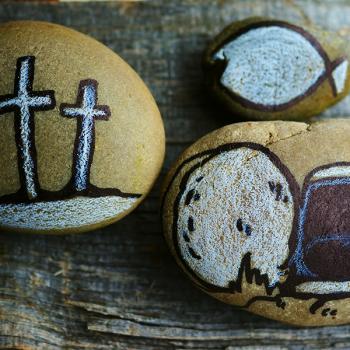In an article posted just this week, John Piper writes about how the cross has efficacy because Jesus lived an obedient life. In the debates about the atonement, some people criticise us for over-emphasising the cross at the expense of the incarnation or resurrection. I have been arguing in my series on the resurrection that the cross and resurrection are an inseparable unit. Here Piper argues that the cross and Jesus’ obedience as a man throughout his life are also inseparable
If you put these ideas together, you come up with the conclusion — which might seem obvious, but nonetheless is worth saying in this climate of debate — Jesus life, death, and resurrection as a unitary event planned before the foundation of the world saved us. If you like, Jesus was our obedience substitute during his life, our punishment substitute in His death, and our rebirth substitute in His resurrection. The doctrine of unity with Christ teaches us that we become united with Jesus in such a way that His life of obedience, death of pain, and resurrection into glorious power are all credited to our account! What a Saviour!
Here is some of what Piper said:
“. . . so the death of the Son of God is sufficient to cover all our sins as the climax of a sinless life. This is no disparagement to the cross. It is not adding to the cross. The New Testament writers saw the death of Christ as the climax of his life. His whole life was designed to bring him to the cross (Mark 10:45; John 12:27; Hebrews 2:14). That is why he was born, and why he lived. To speak of the saving effect of his death was therefore to speak of his death as the sum and climax of his sinless life.
Similarly, the final obedience of Christ in his death is sufficient to justify his people as the climax of a sinless life. It is not likely that the apostles thought of Jesus’ obedience on the cross as separate from his obedience leading to the cross. Where would one draw the line between his life of sinless obedience and the final acts of obedience? Any line would be artificial. Do we draw it at the point where he submitted to the piercing of his hands? Or at the point when he submitted to his arrest in the garden? Or at the point where he endured Judas’ departure from the supper? Or at the point where he planned his final entry to Jerusalem? Or at the point where he “set his face to go to Jerusalem” (Luke 9:51)? Or at the point of his baptism where he said, “It is fitting for us to fulfill all righteousness” (Matthew 3:15)?
It is more likely that when Paul spoke of Jesus’ obedience as the cause of our justification he meant not merely the final acts of obedience on the cross, but rather the cross as the climax of his obedient life. This seems to be the way Paul is thinking in Philippians 2:7-8: “He emptied himself . . . being born in the likeness of men. And being found in human form, he humbled himself by becoming obedient to the point of death, even death on a cross.” Notice the sequence of thought: He became a human. That is, he was found in human form. >>> He humbled himself. >>> The way he humbled himself was by becoming obedient. >>> This obedience was so complete that it willingly embraced death. >>> Even death in the most painful and shameful way—on a cross.
What this text shows is that between “being born in the likeness of men” at one end of his life and “even death on a cross” at the other end of his life was a life of self-humbling obedience. The fact that it came to its climax on the cross in the most terrible and glorious way is probably what causes Paul to speak of the cross as the sum and climax of all his obedience. But it is very unlikely that Paul would have separated the obedience of the final hours from the obedience that designed, planned, pursued, and embraced those final hours . . . .”














